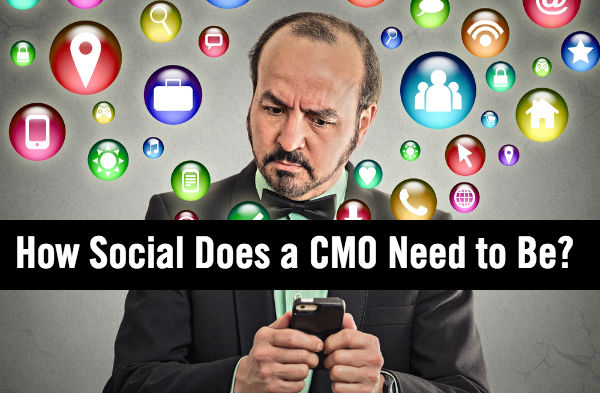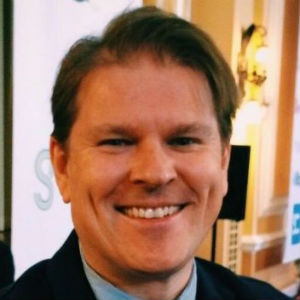Explosive growth of social networks has attracted considerable attention to CEO and executive use of social media. Optimism about executive social media impact has been fueled in part by studies like the BRANDfog survey, which reports executive social participation leads to better leadership, creates more brand transparency and helps build better connections with customers, employees, and investors.
The CMO is one of the most visible people within a company and as a public facing marketing role, there is an expectation that the chief marketing officer will be active on social networks. But how many tweets, likes, shares and snaps is enough?
It is tempting for senior marketing executives to hold themselves up in comparison to professional marketing influencers who spend virtually all of their time keynoting conferences, writing books and being interviewed by the media – aka individuals as brands, or as I like to call them, “brandividuals”.
A review of the latest list of the most influential CMOs will reveal a number of executives that have been able to achieve a unicorn-like duality of maintaining their organizational responsibilities as well as an active social media presence like Beth Comstock from GE or Jonathan Mildenhall from Airbnb. But that is certainly not the norm.
In fact, only 49 of Marketing Magazine’s Power 100 have a Twitter account and many of them post infrequently or simply RT others’ tweets.
Clearly, many senior marketing executives and CMOs are still working out what an appropriate level of social engagement looks like. To help provide perspective, I reached out to several senior executives for their views on a basic question, “Should senior marketing executives be active on social networks?”
The CEO:
“It’s crucial to be aware of social trends and influencers, so I would always encourage my team to be active on social media. Our clients are PR and comms professionals and it’s their job to amplify messaging and engage with target audiences – a lot of which is done on social, so we all need to be part of that conversation. What’s more, analysis of these engagements is the core of what we do. This helps our clients prove their worth and provides actionable insight into their PR strategy. So in short – absolutely yes.”
Jeremy Thompson @JeremyCThompson
CEO EMEA at Cision / PR Newswire
The CMO:
“The strongest senior execs track their social pulse every day because it’s the freshest, fastest way to keep up with the voice of their customer. The weakest? Well, their assistants are still printing their emails! No one expects a senior exec to be on every platform, every day. But any wise person knows the value of walking the floor, of understanding the terrain, and of being able to speak from the confidence of doing, not just knowing. So every decent senior exec has to have some social experience themselves. It’s finding what works best for them and their business that matters.”
Will McInnes @willmcinnes
CMO at Brandwatch
The Marketing Director:
“Yes. It’s not only a golden opportunity to get familiar with the tools your own customers are using, it’s also an easy way to ensure you don’t become a digital dinosaur, which can happen to anyone. Quickly. Going one step further, I would also question any marketer who lacks the curiosity to at least try out social. It’s all about having a growth mindset. Curiosity leads to experimentation which leads to innovation. Without which, brands may stagnate and fall behind their competitors.”
John Watton @jwatton
Marketing Director, at Adobe
The Agency:
“I’ll cite three reasons:
1. If you believe as I do, that the future of organizational communication is social, then as a business leader you need to become confident and conversant in the social web.
- You can’t begin to understand the social web unless you participate. It isn’t a spectator support. Doing is the most authentic form of sales. Show rather than tell.
- Finally, executives that are active on social media, benefit from the profile and network benefits of creating their own media and networks.”
Stephen Waddington @wadds
Partner and Chief Engagement Officer at Ketchum
3 Essential Guidelines for CMO Social Media Success:
It’s pretty clear from all executive perspectives surveyed, that a commitment to being active on social networks is imperative, if not a practical function of marketing leadership. If faced with some uncertainty about how to find the right balance, CMOs and senior marketing executives can follow these three guidelines for meaningful and manageable social media success.
- Set a goal: Be specific – There are myriad possibilities with social media but even the thought of that can paralyze one’s effort to start. Begin with a singular goal. What is one thing you hope to accomplish by being visible and connected on the social web? Focus on that one thing and even go so far as to make a goal statement articulating what you hope to accomplish and how you plan to achieve it. The goal might simply be to reinforce your thought leadership on a specific topic or it might be to make yourself available to customers, prospects and the media. Just decide and commit.
- Curate: Be useful. Leverage a social monitoring tool like BuzzSumo, the search feature on Twitter or your normal digital news sources to find interesting articles, posts, videos and other kinds of content to share with your social network. Add some of your perspective to curated information that consistently follows the theme that supports your goal. Share your own content as well. Become the “best answer” for what it is you want to be known for by building thought leadership with useful curation plus insight.
- Interact and instigate: Be engaging. Much of social media’s value is in engagement and exchanges of ideas with your community. Use a social media listening tool to surface mentions of your name, brand and social content. Interact, show appreciation for the behaviors and messages that align with your goal. Ask your community questions that would lead to discussion and conversation around topics that can lead to your messaging and social media goals. Listen for questions being asked where your helpful answer can help lead that person to a positive experience.
Being specific in your goal, sharing useful content from other sources as well as from your brand and engaging with your community are three of the fundamental things a senior executive can do on social networks.
Make these core activities part of a process and a daily habit. Identify the tools you’ll need and set up alerts so you can spend a small, consistent amount of time building your social presence on a regular basis. With a little planning and tools, you can accomplish important visibility, thought leadership and customer engagement goals in just a few minutes a day.
This article originally appeared on CMO.com.
Gain a competitive advantage by subscribing to the
TopRank® Online Marketing Newsletter.
© Online Marketing Blog - TopRank®, 2016. | How Social Do Senior Marketing Executives and the CMO Need To Be? | http://www.toprankblog.com
The post How Social Do Senior Marketing Executives and the CMO Need To Be? appeared first on Online Marketing Blog - TopRank®.





No comments:
Post a Comment